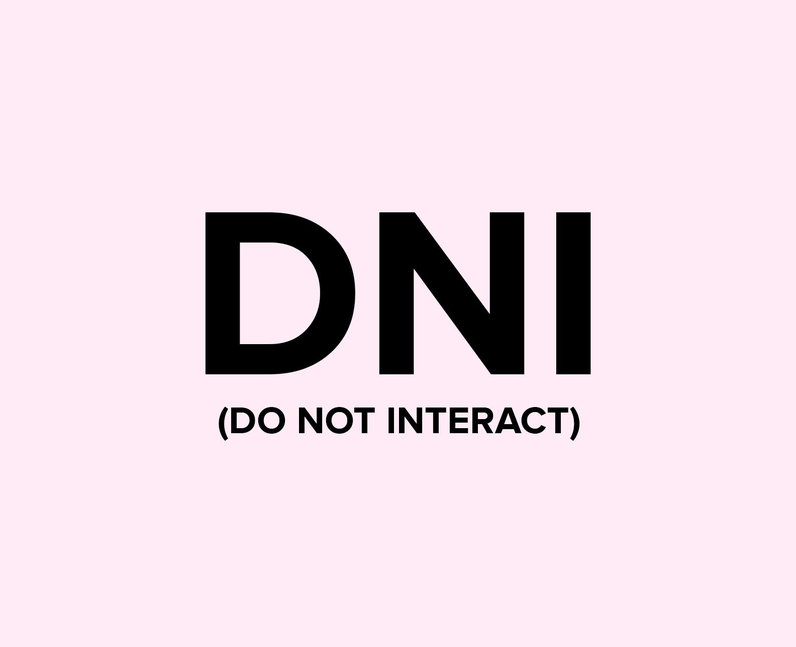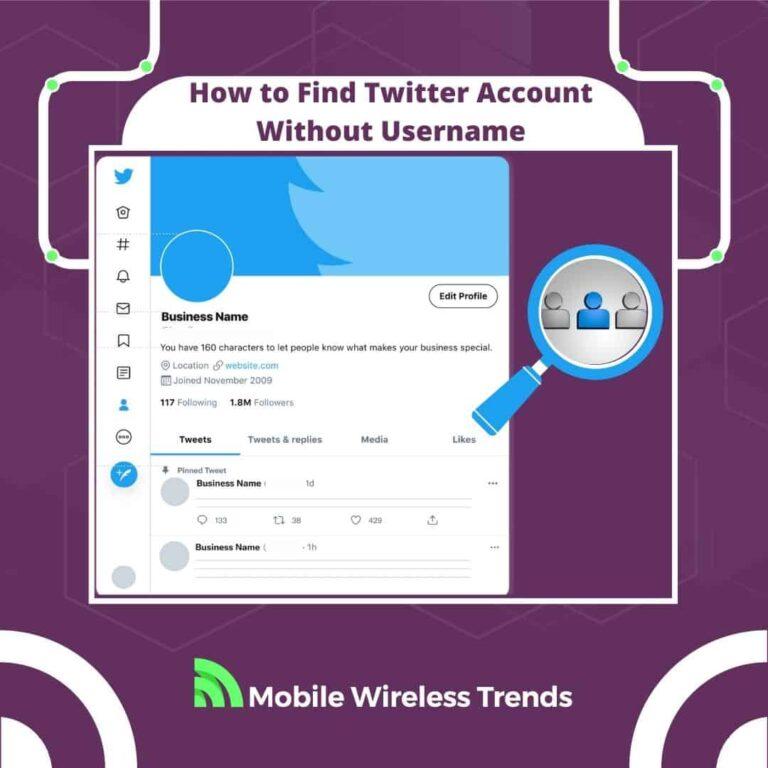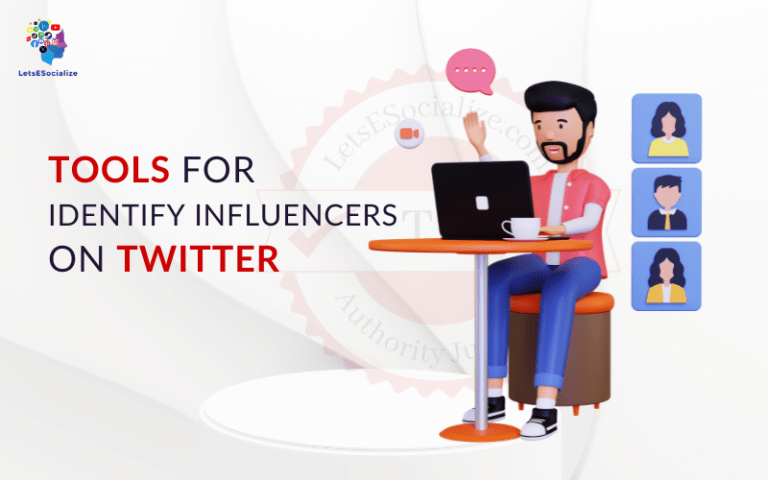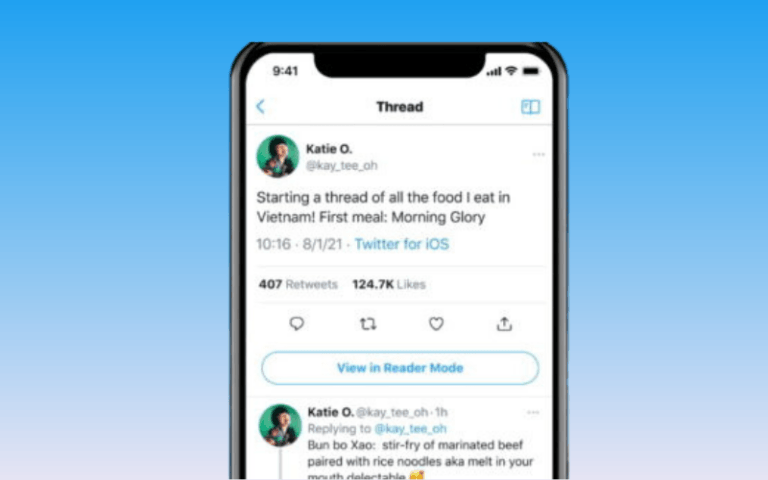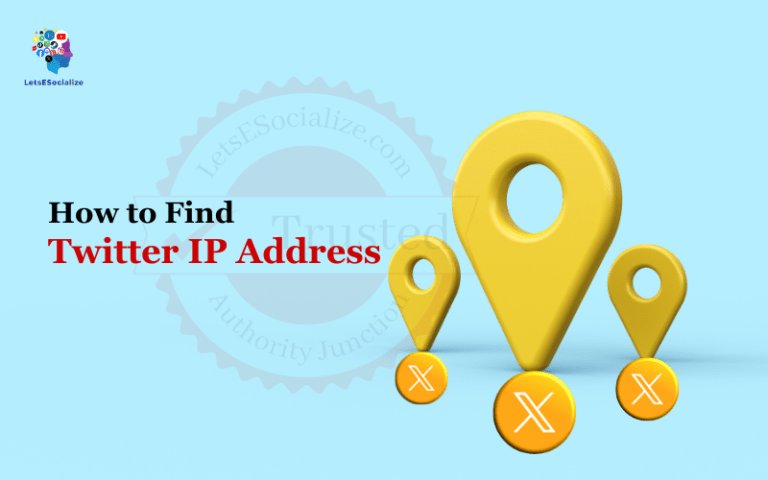Social media has created its own language over the years, with Twitter being a prime example. The platform’s character limits led to the creation of a whole host of acronyms and shorthand to convey meaning in quick, bite-sized posts.
One such acronym that has become popular on Twitter is “DNI,” which stands for “Do Not Interact.” In this comprehensive guide, we will explore the meaning of DNI, how to use it properly, and best practices for engaging on social media.
Table of Contents
What Does DNI Mean on Twitter?
On Twitter, “DNI” stands for “Do Not Interact”. It’s a term used in bios and tweets to communicate boundaries and preferences regarding online interactions.
Here’s how it works:
- Usage: Users may include “DNI” in their bio or posts followed by specific groups or characteristics they wouldn’t like to interact with. For example, “DNI pro-life accounts” or “DNI negativity, I need positivity.”
- Purpose: DNI serves as a preemptive filter, setting expectations for who can engage with the user’s content. It helps users create a safer and more comfortable online space by minimizing unwanted interactions.
- Common DNI categories: While personal preferences vary, some common DNI categories include:
- Political views: Users might specify opposing ideologies they don’t want to engage with.
- Triggering content: People with specific triggers might want to avoid accounts posting related content.
- Hate speech or negativity: Users might discourage interactions from those spreading negativity or hate.
- Specific fandoms or communities: Some users might prefer to keep their online space focused on specific interests and avoid discussions off-topic.
Remember: DNI is a valuable tool for online safety and comfort. By using and respecting it responsibly, we can create a more inclusive and positive Twitter experience for everyone.
Also read: Demystifying Twitter NSFW Policy: A Detailed Guide
Key Signs Someone Doesn’t Want You to Interact
There are a few key indicators that someone on Twitter does not want you interacting with their content:
- DNI in bio: If a user has DNI in their bio, do not engage with any of their tweets. This is a blanket request to be left alone.
- DNI at the start of a tweet: Placing DNI at the beginning of a specific tweet limits the request to that post only. You can still engage with their other content.
- Specifying a group: Some users get more granular with DNI requests, calling out specific identities, ideologies, groups, etc. For example: “DNI if you’re a terf” or “DNI if you’re a crypto bro.”
- Blocked: If you cannot view someone’s profile or engage with their content, chances are you’ve been blocked. This is a non-negotiable DNI.
Adhering to these requests and not interacting with content prefaced by DNI is vital social media etiquette. It’s all about consent – and DNI establishes a clear lack of support for engagement.
Why Do People Use DNI on Twitter?
There are a few key reasons someone may preface tweets or their bio with a DNI disclaimer:
1. To Avoid Harassment and Abuse
Unfortunately, harassment continues to be an issue on social media. Groups that face frequent harassment, like women, people of color, and LGBTQ+ users, often use DNI to proactively block bad-faith accounts from engaging. This prevents dogpiling and protects mental health.
2. To Maintain a Safe Space
DNI is commonly used by marginalized groups and communities looking to establish a safe space free of hate, judgment, and bigotry. Keeping their conversations contained helps maintain the integrity of these spaces.
3. To Control Reach and Exposure
Placing DNI on select tweets for public figures and brands prevents harmful commentary from being amplified to a wider audience. DNI gives them control over how tweets spread.
4. To Limit Unwanted Interactions
Some users simply add DNI to their bio or tweets to control who engages with their content. This helps them curate interactions and focus on conversations with actual value.
5. To Encourage Critical Thinking
Prefacing tweets with DNI of specific groups – say climate change deniers, for example – encourages readers to think critically about the content rather than reactively engage.
Using DNI for any of these reasons is perfectly acceptable. It establishes important boundaries and consent on social platforms.
Also read: Twitter Can’t Complete Sign Up: A Comprehensive Guide to Fixing the Error
How to Use DNI on Twitter Properly
DNI is powerful but easily misused if you don’t adhere to proper etiquette. Here are a few key tips:
1. Specify Your Boundaries:
- Identify categories: What kind of interactions do you want to avoid? Examples include negativity, specific political views, hate speech, triggering content, or specific fandoms.
- Choose wording: Be clear and concise in your wording. You can use direct statements like “DNI pro-life accounts” or phrases like “Negativity unwelcome here, seeking positivity.”
- Consider tone: Use respectful and non-aggressive language. Remember, the goal is to set boundaries, not to offend or alienate anyone.
2. Placement Options:
- Bio: This is the most common and visible location. Users often scan bios before interacting, making it a clear upfront statement.
- Pinned Tweet: Pinning a tweet with your DNI list ensures it’s always at the top of your profile, easily accessible to everyone.
- Post as needed: You can occasionally post reminders about your DNI preferences, especially if your content attracts unexpected audiences.
3. Be Consistent and Upfront:
- Stay true to your boundaries: Don’t engage with those who disregard your DNI requests. Blocking might be necessary in some cases.
- Explain when needed: If your DNI criteria are specific or complex, consider adding a brief explanation to your bio or pinned tweet.
4. Respect Other Users’ DNI:
- Pay attention to bios and tweets: Look for DNI requests before interacting with another user’s content.
- Avoid triggering content: If you’re unsure whether your content falls under someone’s DNI criteria, err on the side of caution and avoid posting it.
- Promote a positive environment: By respecting everyone’s boundaries, we can all contribute to a more inclusive and welcoming Twitter community.
Additional Tips:
- Use appropriate hashtags: Some users add hashtags like #DNIMadeIt or #DNIList to their posts for better visibility.
- Avoid negativity: Don’t use your DNI list to attack or belittle others. Focus on setting positive boundaries for yourself.
- Be flexible: Your needs and preferences might evolve over time. Update your DNI list accordingly to reflect your current boundaries.
Remember, using DNI effectively is about creating a safe and comfortable online space for yourself and others. By being clear, respectful, and consistent, you can set healthy boundaries and foster positive interactions on Twitter.
At the end of the day, DNI is a request and not a right. While it should be respected, you cannot force compliance. Lead by example online, even when others do not.
Common DNI Confusion and Controversy
Given how prevalent DNI has become on Twitter, there are also plenty of misconceptions and debates over proper usage:
DNI vs. Blocking
Blocking is far more severe than DNI, preventing users from viewing your profile or posts. Some save blocking only for cases of abuse and harassment, using DNI as a less extreme option for curating interactions.
DNI Hypocrisy
There can be backlash when a user places DNI on their content but then interacts with others who have requested to be left alone. However, DNI is a request and not a rule, so there are no grounds for calling out this behavior.
Vague DNI Requests
As mentioned earlier, some deem vague DNI statements like “DNI if you’re weird” ineffective and harmful. Specificity is ideal. However, others counter that marginalized groups shouldn’t have to cater requests to their oppressors. There are valid points on both sides.
DNI as a Cop Out
Some believe preemptively placing DNI on content is a cop-out to limit criticism or avoid healthy debate. But DNI users argue it’s about managing mental health and weeding out unproductive interactions. There’s logic to both perspectives.
As with most discourse online, there are multiple lenses through which to view DNI usage on Twitter. Maintaining nuance is key.
Also read: Can People See What You Search on Twitter? Know the Latest Privacy Hacks in 2023
What are Some Common DNI Statements Used on Twitter?
Twitter users can get creative with their DNI statements to really tailor who can and can’t engage. Here are some of the most common things people choose to DNI on their profiles or tweets:
- Political affiliations
- Ex. “DNI if you vote Republican” or vice versa
- Stances on human rights issues
- Ex. “DNI if you’re anti-choice” or “DNI if you don’t support BLM”
- Fandom preferences
- Ex. “DNI if you ship Reylo” or “DNI if you don’t stand LOONA”
- Spoilers
- Ex. “DNI if you haven’t seen the S4 finale yet”
- Tone preferences
- Ex. “DNI if you think tone policing is real” or “DNI if you’re not sex positive”
- Identities
- Ex. “DNI if you’re cishet” or “DNI if you’re white”
As you can see, DNI statements allow users to get very specific about who they want to hear from and engage with in their online spaces.
What Does “MDNI” Mean on Twitter?
MDNI stands for “minor DNI”. It operates similarly to standard DNI, but signals more flexibility with who can engage:
- For less divisive topics vs human rights concerns
- Room for nuance in stances
- Lighter restrictions on tone/fandom debates
- More openness to respectful disagreement
So MDNI tends to get used around preferences like spoilers, ships, entertainment opinions etc where there is room for reasonable debate. The standard DNI is reserved for shielding marginalized identities or protecting mental health.
Twitter’s Ongoing DNI Conversations
Given how pronounced DNI usage is on the platform, Twitter itself has entered the discourse:
Surveying User Sentiment
In 2022, Twitter posted a poll asking users if they support or oppose using DNI on the platform. This was an attempt to take the temperature of user sentiment and see if any policy action around DNI was warranted.
The poll results indicated that the overwhelming majority support people’s right to use DNI, likely halting restrictive policy changes.
Elon Musk Weighs In
After acquiring Twitter in late 2022, CEO Elon Musk clarified by tweeting, “Twitter needs to become by far the most accurate source of information about the world. That’s our mission.”
Some interpreted this as Musk opposing DNI and other content moderation, viewing unchecked engagement as the key to uncovering “truth.” However, Musk has not enacted any anti-DNI policies at this point.
Monitoring the Situation
Twitter appears content to take a hands-off approach, neither endorsing nor opposing DNI. They seem to view it as an emerging norm worthy of ongoing observation and discussion before intervening with a formal policy.
So, DNI remains a common factor in the Twitter landscape for the foreseeable future. The onus falls on each of us to use the tactic judiciously.
Also read: Why Are Bots Following Me on Twitter?
Looking Ahead: The Evolution of DNI
It’s unlikely we’ve seen the end of innovations and iterations on DNI as users continue adapting it to suit their needs:
- DNI timing – Placing DNI on tweets preemptively vs reactively in response to bad faith engagement
- DNI exceptions – Carving out exceptions like “DNI unless you’re complimenting my outfit.”
- DNI as subscriptions – Paywalls and subscriptions that block users lacking “verified ally” status
- Ownership – Debates over who “owns” DNI and can permit engagement, the poster, or target community.
- Scope – Using DNI on a per-tweet vs permanent account-wide basis
- Automation – Bots auto-appending DNI to posts containing key terms most susceptible to harassment
- Sentiment analysis – Scanning incoming replies to predict bad faith actors and auto-apply DNI before engagement snowballs
Social networks are constantly adapting to how users behave “in the wild” vs. dictated by top-down policies. DNI and its variants will likely become further nuanced over time.
In Summary: Principled Engagement Wins Out
Much remains open to interpretation regarding proper DNI usage on Twitter. But a few key takeaways are:
- Lead with empathy and assume the best intent when encountering DNI
- Never demand DNI of others or harass those who don’t comply
- Specify groups clearly and avoid blanket labels open to misinterpretation
- Focus on creating your own safe spaces vs policing how others do so
- Stay mindful of requests, but recognize DNI is not an absolute rule others must obey
Rather than getting lost in the endless debate around DNI, focus your energy on having a constructive dialogue of value. The rest works itself out.
Principled engagement and conversation – the kind that brings us together vs divides us – remains the true social media ideal. And it starts with each of us.
Does DNI Really Work on Twitter?
This is a big question around using DNI. Ultimately, it comes with notable limitations:
- It has no real enforcement other than the block button.
- Many people still interact without reading bios or DNI statements.
- Anonymous/throwaway accounts often ignore DNI rules.
However, when used properly DNI can provide some effectiveness at:
- Establishing expectations and boundaries around interactions.
- Deterring decent Twitter citizens who want to respect DNI culture.
- Identifying whom to block that violates your stated DNI policy.
So DNI works imperfectly, but provides some scope to improve your connections/conversations.
Frequently Asked Questions About DNI on Twitter
Still, have questions about how to interpret and engage with DNI on Twitter? Here are answers to some commonly asked questions:
-
What Does DN Mean on Twitter?
DN stands for “display name” and refers to the name shown on your Twitter profile, as opposed to your @ handle. Users sometimes change their display name as a form of protest, such as setting it to a social cause or awareness ca instead of Your DN, the Same as Your Twitter ID.
No, your display name (DN) and Twitter handle (like @username) are separate. Your handle is unique and unchangeable, used for tagging and mentioning. Your DN can be changed freely to reflect identities or causes. -
Can You Change Your DNI on Twitter?
You can change your display name (DN) anytime in your Twitter account settings. There is no limit to how often you can change it. Your @ handle, however, cannot be altered once created.
-
What Does DNI Mean on Tumblr?
DNI is Iton Tunlimitedst like Twitter, standing for “do not interact.” Placing it on posts establishes boundaries that specific users or groups should not like, reblog, or comment on that content. It preemptively opts out of undesired engagement.
-
What Does MDNI Mean on Twitter?
MDNI stands for “media do not interact.” This is typically used by artists and content creators who do not want their work reposted or shared without consent. MDNI protects copyright and establishes boundaries on sharing media.
-
What Does VN Mean on Twitter?
VN stands for “via name” and is used when crediting a source in a retweet. For example, quoting a tweet and adding “VN @username” indicates you saw the tweet through that person’s profile or timeline, even if they did not originate it.
-
What Does Y/N Mean on Twitter?
Y/N stands for “yes or no” and is typically used to turn tweets into impromptu Twitter polls. Tweeting a statement, question, or proposal followed by Y/N lets readers respond with simple yes or no answers rather than lengthier replies.
-
What Does RT Mean on Twitter?
RT stands for “retweet” and indicates that you are reposting someone else’s tweet to share it with your followers on Twitter. RT helps attribute the original tweet rather than taking credit for the content.
-
Can I just ignore DNI on a Twitter profile if I disagree?
Ignoring clearly stated engagement boundaries is considered extremely rude on Twitter and often viewed as digital harassment. Users have faced consequences like mass reporting and blocking by doing so. Respect DNI preferences.
Conclusion
This comprehensive guide covers everything you need to know about properly using DNI on Twitter, avoiding confusion, and practicing principled social media engagement. The key is maintaining consent, empathy, and constructive dialogue.

